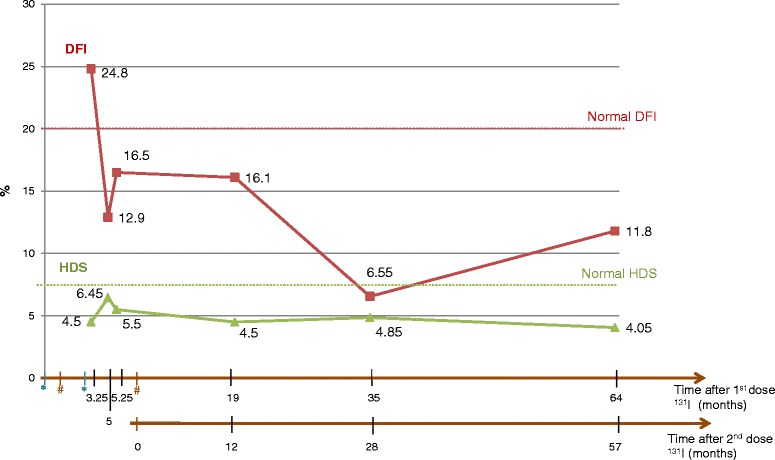Sperm DNA fragmentation after radioiodine treatment for differentiated thyroid cancer
- PMID: 26236480
- PMCID: PMC4522285
- DOI: 10.1186/s12610-015-0024-1
Sperm DNA fragmentation after radioiodine treatment for differentiated thyroid cancer
Abstract
Background: Treatment of differentiated thyroid cancer usually consists of a total thyroidectomy followed by one or several courses of radioiodine ((131)I). (131)I is known to have deleterious effects on radiation sensitive tissues and irradiation to the testes has been shown after its administration. We investigated effects of such treatment on sperm DNA in a patient with differentiated thyroid carcinoma.
Methods: The patient, a 32-year-old male with differentiated thyroid carcinoma treated by total thyroidectomy and radioiodine therapy, performed 6 semen samples in total, 3 for sperm banking and 3 for semen exploration, that were analysed for classic semen parameters. DNA integrity was analysed by flow cytometry: sperm DNA fragmentation index (DFI) and high DNA stainability (HDS) were analyzed by sperm chromatin structure assay, DNA fragmentation was analyzed by terminal deoxynucleotidyl transferase dUTP nick end labeling assay.
Results: Moderate oligozoospermia was observed as early as 3 months after a first dose of (131)I and became severe at 5 months. Total sperm count was reduced up to 12 months after the second dose of (131)I. Sperm DFI was increased 3.25 months after the first dose of (131)I. All parameters returned to normal values 28 months after the second (131)I dose.
Conclusions: Treatment with (131)I induces alterations in sperm chromatin as well as in sperm parameters a short time (3 months) after a first dose of (131)I with persistence of sperm alterations until 12 months after a second dose. Sperm banking should be recommended before treatment.
Contexte: Le traitement du cancer différencié de la thyroïde consiste en général en une thyroïdectomie totale suivie d’un traitement par l’iode radioactif (131I). L’131I est connu pour ses effets délétères sur les tissus sensibles aux radiations et il a également été démontré une irradiation des testicules après administration d’iode radioactif. Nous avons donc cherché à savoir quels étaient les effets du traitement par l’iode radioactif sur l’ADN des spermatozoïdes.
Méthodes: Le patient est un homme de 32 ans présentant un cancer différencié de la thyroïde traité par thyroïdectomie totale puis traitement par iodothérapie. Il a réalisé 6 prélèvements de sperme, 3 pour de l’autoconservation et 3 pour le suivi après traitement, dont les caractéristiques spermatiques ont été étudiées suivant les méthodes classiques. L’analyse de l’intégrité de la chromatine a été réalisée par cytométrie en flux : l’index de fragmentation de l’ADN (DFI) et la haute colorabilité de l’ADN (HDS) ont été analysés par le sperm chromatin structure assay (SCSA), la fragmentation de l’ADN a été évaluée par la technique de terminal deoxynucleotidyl transferase dUTP nick end labeling (TUNEL).
Résultats: Une oligozoospermie modérée a été observée dès 3 mois après une première dose de 131I, et est devenue sévère à 5 mois. La numération des spermatozoïdes est restée réduite jusqu’à 12 mois après la seconde dose de 131I. Le DFI est élevé 3.25 mois après la première dose de 131I. Tous les paramètres ont retrouvé des valeurs normales 28 mois après la seconde dose d’131I.
Conclusion: Le traitement par 131I induit des altérations de la chromatine du spermatozoïde en plus de celles des caractéristiques spermatiques une courte période (3mois) après une première dose de 131I, avec persistance de ces altérations spermatiques jusqu’à 12 mois après une seconde dose. L’autoconservation devrait être recommandée avant un tel traitement.
Mots clé: Traitement par iode radioactif, SCSA, fragmentation de l’ADN du spermatozoïde, cancer différencié de la thyroïde, paramètres spermatiques.
Keywords: Cancer; Differentiated thyroid; Radioiodine therapy; SCSA; Semen characteristics; Sperm DNA fragmentation.
Figures


 ) and High DNA Stainability (HDS) (
) and High DNA Stainability (HDS) ( ) were measured on 2 x 106 cells by the SCSA assay. Each dot represents the mean of duplicates for each sample, values are reported on the graph.
) were measured on 2 x 106 cells by the SCSA assay. Each dot represents the mean of duplicates for each sample, values are reported on the graph.  represents surgeries,
represents surgeries,  represents 131I treatments. The Y axis represents the values in % of DFI and HDS
represents 131I treatments. The Y axis represents the values in % of DFI and HDSReferences
-
- Ceccarelli C, Battisti P, Gasperi M, Fantuzzi E, Pacini F, Gualdrini G, et al. Radiation dose to the testes after 131I therapy for ablation of postsurgical thyroid remnants in patients with differentiated thyroid cancer. J Nucl Med. 1999;40(10):1716–21. - PubMed
LinkOut - more resources
Full Text Sources

